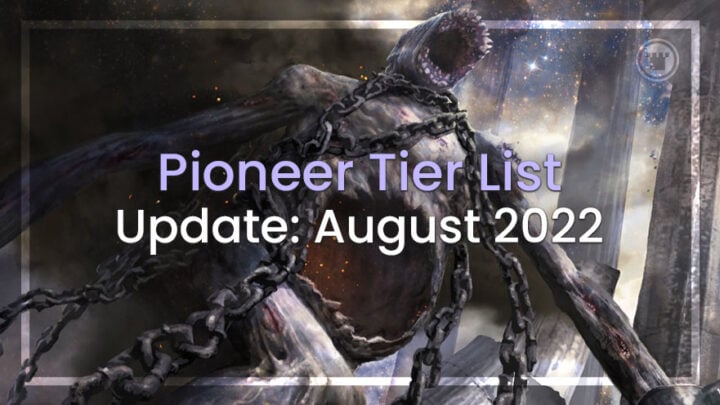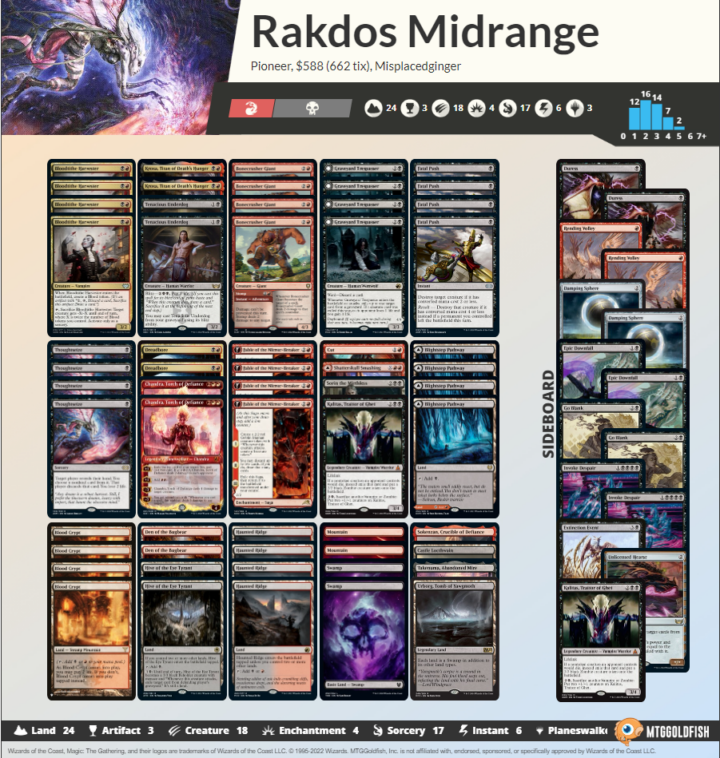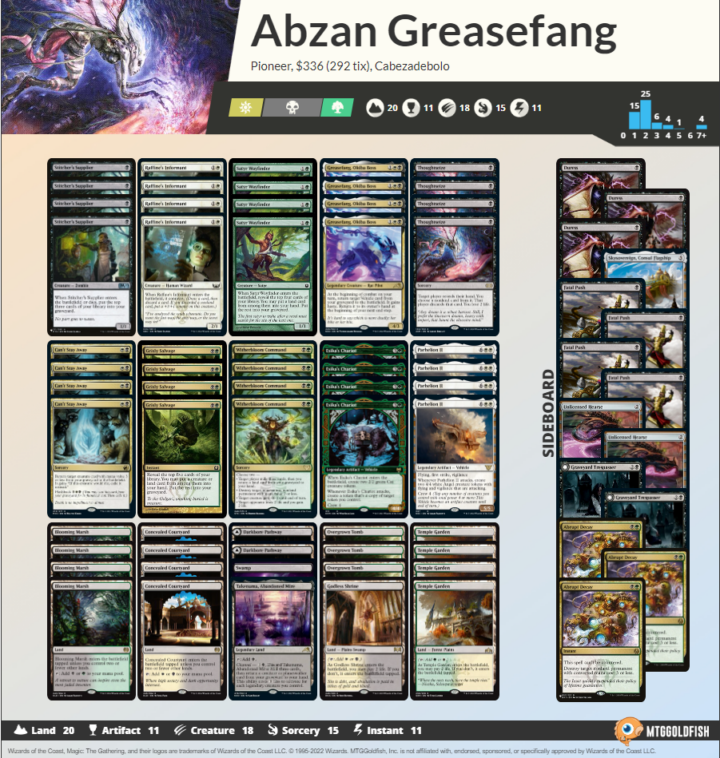It has been just more than a month since our last tier list for Pioneer. A lot has changed in that time, back when people scoffed at Arclight remaining a top deck after Expressive Iteration’s ban and when mono-green was a force in the format that few could answer.
Multiple new decks and innovations on old decks have developed, and now we are looking at a completely different tier list then before.
But before we dive into the list, I want to lay out my grading criteria to help contextualize my recommendations:
S-Tier: Decks that are above the rest. This is normally the default “best deck in the format” and the deck(s) you should have in mind when building or picking your deck.
A-Tier: Decks that are great. These decks are knocking on the door of S Tier, but they may have a small weakness that keeps them out of the upper echelon.
B-Tier: Good, solid decks. You wouldn’t be surprised if a B Tier deck takes down an event, but they have bigger weaknesses or liabilities than the decks in A Tier.
C-Tier: Decks that are totally fine, but not notable. These decks aren’t exactly tearing up the tournament or ladder scene, but you should expect to face them every now and then.
D-Tier: Decks with strong elements, but that generally aren’t great choices compared to the rest of the format.
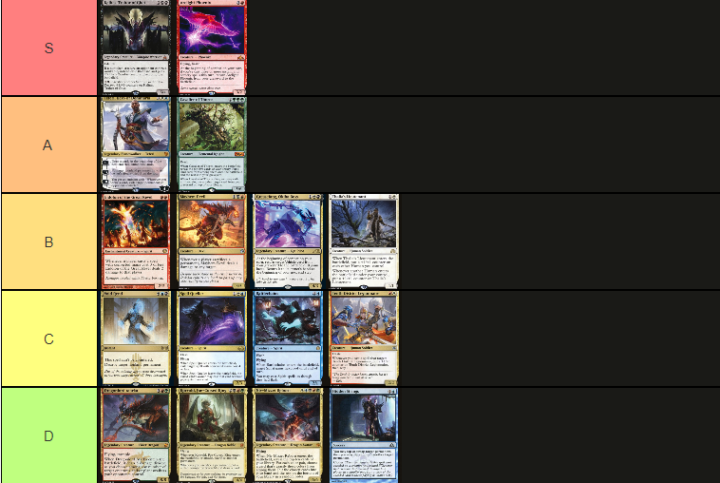
S Tier: Rakdos Midrange and Arclight Phoenix
A Tier: Azorius Control and mono-green Devotion
B Tier: Mono-red, Rakdos Sacrifice, Abzan Greasefang, and Humans
C Tier: Esper Control, Bant Spirits, mono blue Spirits and Boros Heroic
D Tier: Green Red Ramp, Jund Sacrifice, Niv to Light and Lotus Field
That’s the list, but let’s dive a bit deeper to contextualize some of these lists more.
Rakdos Midrange
Let’s get this out of the way, since I am sure many may roll their eyes at RB earning such a high placement. Red Black is the one deck in Pioneer that doesn’t lean on any one axis. That means it’s very hard to break this deck up or to have faulty draws outside of the normal fail rate inherent with all magic decks. On the flip side, Rakdos Mid shines for its ability to break up what an opponent is doing while applying pressure.
You might not like Red Black. You might think its curve is higher than you would like. But in the context of Pioneer, the deck has proven itself consistently at the MTGO challenge level and under, consistently.
Will it hold up at and event like the Regional Championship? Who knows, to be honest? But for now you are hard pressed to find a better and more consistent deck in Pioneer.
Humans
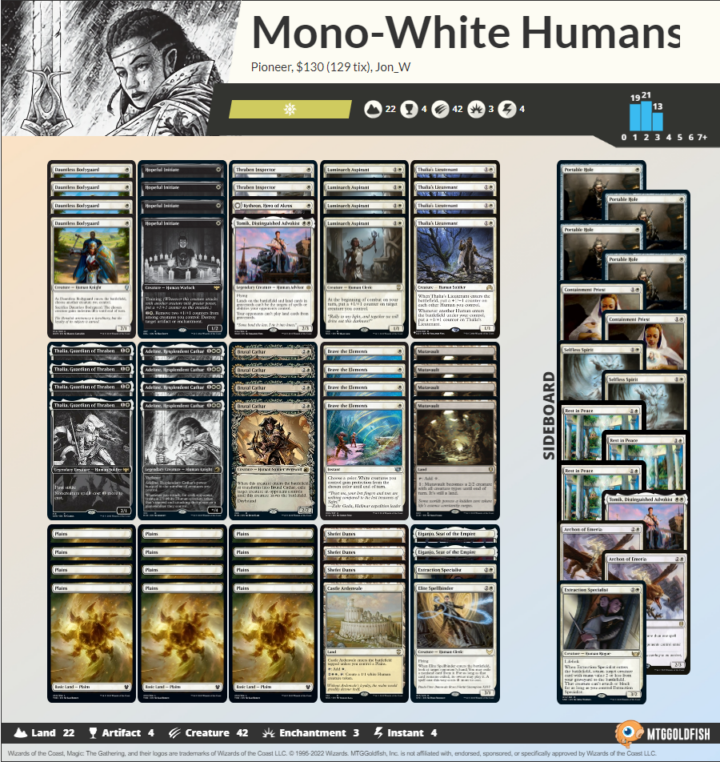
Now there are plenty of other decks higher up on the tier list, but we know how and why those decks work. Let’s dip down a bit and cover both Bant and mono-white Humans, as they are similar decks with similar goals. One just splashes some more powerful cards and the other chooses cleaner mana to stumble less and put people on the back foot off a starting curve more often.
Right now, I prefer the mono-white side of the archetype — and there are two big reasons for that. The first is your mana base is just much stronger. It is a weird thing to think about, but by having a mono-colored mana base, we can play cards like Castle Ardenvale, Mutavault, Eiganjo, and Shefet Dunes, just to name a few.
You also get to do all of that while still just curving out on your opponents, which is the other thing I like so much about this deck. Too often, players undervalue the number of games they lose because their mana is bad — and the Bant Humans deck doesn’t have the best mana ever.
When you look at the mono-white list, one of the things that probably jumps out is just how strong the two drop slot is. This has a few ramifications. Not only does it mean your turn two is always a high impact play, but also that on turn four, you have powerful, double spell turns like Thalia into Luminarch Aspirant.
These early, high impact plays will put most people on the back foot. This also puts your opponent in a spot where, if they stumble, they are going to have a terrible time catching back up. Then combine all of this with Brave the Elements, which is a card that gets to absolutely steal games you have no right winning.
Abzan Greasefang
This is one of the new hotness when it comes to Pioneer. This deck looks to combine the powerful Greasefang and Parhelion strategy that has dominated formats like Explorer and port it over to Pioneer. We have seen Esper versions of this deck before, but the Abzan version has two real strengths over the other builds.
First, it more easily finds the combo piece while actually playing to the board. While Stitcher’s Supplier and Satyr Wayfinder don’t have incredible bodies, they do gum up the board and save you life in ways the Esper deck could not.
In terms of your win condition, you have way more redundancy in your combo. Where Esper is just playing four fang and four Parhelion II. The Abzan deck plays both Esika’s Chariot and Can’t Stay Away. While Can’t Stay Away does need you to have a Greasefang ahead of time, the deck has so much self mill that it’s very easy for that to happen.
While Chariot is not as back breaking for the opponent, it does play well with Greasefang since you can just instantly crew and attack to start building your board up — plus your opponent doesn’t really have any good blocks. If they kill it, that’s fine. We still have Greasefang. And if they don’t, the chariot goes to our hand and we can redeploy it on the next turn.
The second big difference for this over Esper is you’re just better at answering how other decks are trying to answer you. Most graveyard hate in the format is two or less mana, since getting it online early is pivotal for beating phoenix. This means Abrupt Decay easily answers those cards while also being a nice answer to early pressure from aggro decks.
Greasefang will only improve with time, and I think that we will see it shoot up the tier list in equal measure. So, if you’re excited by this deck, it might be a great time to pick it up.
End step
Pioneer continues to be one of the most skill testing and involved formats. It would take more than 10 thousand words just to get this article to cover most of what is in the format.
So, get out there and explore! Remember, every time people think they have the format figured out, they are surprised by innovation weeks later.

Mason Clark is a grinder in every corner of the game who has played at the pro level and on the SCG Tour with Team Nova. Whether he’s competing in Standard, Historic or Modern, Mason plays with one goal in mind: to be a better player than he was the day before. Check out his podcast, Constructed Criticism, and catch his streams on Twitch.

